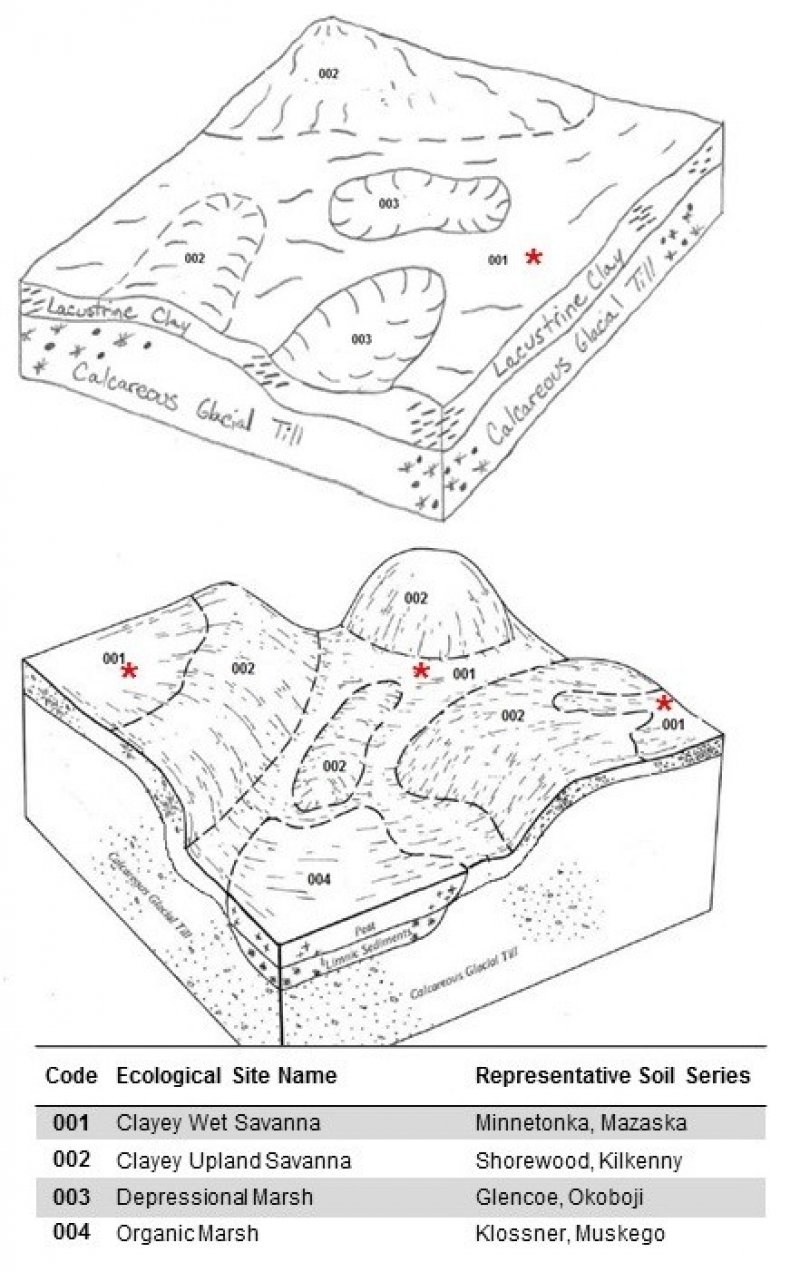
Natural Resources
Conservation Service
Ecological site R103XY023MN
Clayey Wet Savannas
Last updated: 10/04/2023
Accessed: 04/02/2025
General information
Provisional. A provisional ecological site description has undergone quality control and quality assurance review. It contains a working state and transition model and enough information to identify the ecological site.
MLRA notes
Major Land Resource Area (MLRA): 103X–Central Iowa and Minnesota Till Prairies
MLRA 103 is in Minnesota (56 percent) and Iowa (44 percent) and consists of approximately 18 million acres. It is in the Western Lake Section of the Central Lowland Province of the Interior Plains in an area known as the "Des Moines Lobe" of the Wisconsin-age ice sheet. The MLRA is mostly on a young, nearly level to gently rolling, glaciated till plain that has moraines and glacial lake plains in some areas. The plain is covered with glacial till, outwash, and glacial lake deposits. Recent alluvium consisting of clay, silt, sand, and gravel fill the bottoms of most of the major river valleys. Paleozoic bedrock sediments, primarily shale and limestone, underlie the glacial deposits in most of the area.
The annual precipitation increases from northwest to southeast. Most of the rainfall occurs as high-intensity, convective thunderstorms during the summer. Two-thirds or more of the precipitation falls during the freeze-free period. Snowfall is common in winter. Ground water supplies are adequate for the domestic, livestock, municipal, and industrial needs. Nearly all of this area is farmland, and about four-fifths is cropland.
Classification relationships
Major Land Resource Area (MLRA): Central Iowa and Minnesota Till Prairies (103) (USDA Handbook 296, 2006)
USFS Subregions: North Central Glaciated Plains Section (251B); Upper Minnesota River-Des Moines Lobe (251BA) and Southern Des Moines Lobe (251Be) Subsections (Cleland et al. 2007)
Ecological site concept
The Clayey Wet Savannas ecological site is characterized by poorly drained, fine-textured soils that developed under a mix of native wet tolerant grasses and scattered trees. No flooding or ponding occurs on this site, but the seasonal high depth to soil saturation is between 0-30 cm. Grazing, drought, and periodic fires are important disturbance triggers that influence plant community structure and composition.
Associated sites
| R103XY021MN |
Clayey Upland Savannas The Clayey Upland Savannas ecological site is characterized by a savanna community on soils derived from clayey till and lacustrine materials. Drainage class ranges from moderately well to somewhat poorly drained. |
|---|
Similar sites
| R103XY022MN |
Loamy Wet Savannas The Loamy Wet Savannas ecological site is located on soils that are derived from fine loamy till. Soils are classified as poorly drained. This site occurs on morainal ridges or in slight concavities and linear segments with a slope of less than 2 percent. |
|---|
Table 1. Dominant plant species
| Tree |
(1) Populus tremuloides |
|---|---|
| Shrub |
Not specified |
| Herbaceous |
(1) Andropogon gerardii |
Click on box and path labels to scroll to the respective text.
Ecosystem states
| T1A | - | Tillage, drainage, planting crops |
|---|---|---|
| T1B | - | Absence of natural fire regime, increase in woody vegetation, and invasion of non-native species |
| R3A | - | Restoration activities |
| T3A | - | Tillage, drainage, planting crops |
State 1 submodel, plant communities
State 2 submodel, plant communities
| 2.1A | - | Establishment of grass species |
|---|---|---|
| 2.2A | - | Transition to row crop agriculture |



